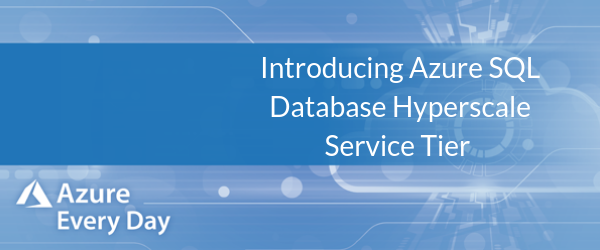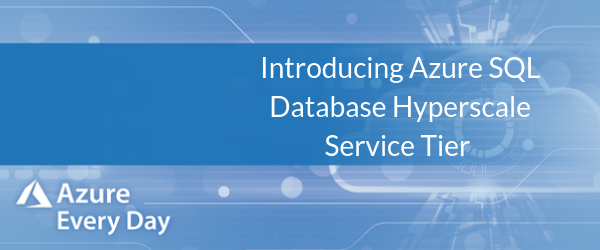Introducing Azure SQL Database Hyperscale Service Tier


If your current SQL Database service tier is not well suited to your needs, I’m excited to tell you about a newly created service tier in Azure called Hyperscale. Hyperscale is a highly scalable storage and compute performance tier that leverages the Azure architecture to scale out resources for Azure SQL Database beyond the current limitations of general purpose and business critical service tiers.
The Hyperscale service tier provides the following capabilities:
- Support for up to 100 terabytes of database size (and this will grow over time)
- Faster large database backups which are based on file snapshots
- Faster database restores (also based on file snapshots)
- Higher overall performance due to higher log throughput and faster transaction commit time regardless of the data volumes
- The ability to rapidly scale out. You can provision one or more read only nodes for offloading your read workload for use as hot standbys.
- You can rapidly scale up your compute resources (in constant time) to accommodate heavy workloads, so you can scale compute up and down as needed just like Azure Data Warehouse
Who should consider moving over to the Hyperscale tier? This is not an inexpensive tier, but it’s a great choice for companies who have large databases and have not been able to use Azure databases in the past due to its 4-terabyte limit, as well as for customers who see performance and scalability limitations with the other 2 service tiers.
It is primarily designed for transactional or OLTP workloads. However, it does support hybrid and OLAP workloads, but something to keep in mind when designing out your databases and services. It’s also important to note that elastic pools do not support the Hyperscale service tier.
How does it work?
- You separate the compute and storage out into 4 separate nodes similar to Azure Data Warehouse.
- The compute node is where the relational engine lives or where the querying process happens.
- The page server node is where the scaled-out storage engine resides and where database pages are served out to the compute nodes on demand and keeps pages updated as transactions update data, so these nodes are moving the data around for you.
- The log service node is where the log records are kept as they come in from the compute node and kept in a durable cache, then they’re forwarded along to additional compute nodes and caches to ensure consistency. When all this is spread out and everything is consistently spread across the compute nodes, it will get stored in Azure storage for long term storage of your logs.
- Lastly, the Azure storage node is where all the data is pushed from the page servers. So, all the data that eventually lands in the database gets pushed over to Azure storage and this is also the storage that gets used for backups, as well as where the replication between availability groups happens.
This Hyperscale tier is an exciting opportunity for those customers that don’t have their requirements fulfilled with prior service tiers. It’s another great Microsoft offering that’s worth checking out if you have had these service tier issues up to now. And it helps to leave a line of distinction between Azure Data Warehouse and Azure Database because you now can scale out/up and tons of data, but it’s still built out for the transactional processing, as opposed to Azure Data Warehouse which is more of the analytical or massively parallel processing.
If you have any questions about this new service tier, service tiers in general or any Azure product or service, we are your best resource. Click the link below or contact us – we’d love to help.
Sign-up now and get instant access

ABOUT THE AUTHOR
Free Community Plan
On-demand learning
Most Recent
private training



.jpg?width=406&name=Eans%20YouTube%20Thumbnails%20(2).jpg)


-1.png)
Leave a comment